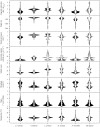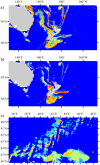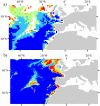Global habitat suitability for framework-forming cold-water corals
- PMID: 21525990
- PMCID: PMC3078123
- DOI: 10.1371/journal.pone.0018483
Global habitat suitability for framework-forming cold-water corals
Abstract
Predictive habitat models are increasingly being used by conservationists, researchers and governmental bodies to identify vulnerable ecosystems and species' distributions in areas that have not been sampled. However, in the deep sea, several limitations have restricted the widespread utilisation of this approach. These range from issues with the accuracy of species presences, the lack of reliable absence data and the limited spatial resolution of environmental factors known or thought to control deep-sea species' distributions. To address these problems, global habitat suitability models have been generated for five species of framework-forming scleractinian corals by taking the best available data and using a novel approach to generate high resolution maps of seafloor conditions. High-resolution global bathymetry was used to resample gridded data from sources such as World Ocean Atlas to produce continuous 30-arc second (∼1 km(2)) global grids for environmental, chemical and physical data of the world's oceans. The increased area and resolution of the environmental variables resulted in a greater number of coral presence records being incorporated into habitat models and higher accuracy of model predictions. The most important factors in determining cold-water coral habitat suitability were depth, temperature, aragonite saturation state and salinity. Model outputs indicated the majority of suitable coral habitat is likely to occur on the continental shelves and slopes of the Atlantic, South Pacific and Indian Oceans. The North Pacific has very little suitable scleractinian coral habitat. Numerous small scale features (i.e., seamounts), which have not been sampled or identified as having a high probability of supporting cold-water coral habitat were identified in all ocean basins. Field validation of newly identified areas is needed to determine the accuracy of model results, assess the utility of modelling efforts to identify vulnerable marine ecosystems for inclusion in future marine protected areas and reduce coral bycatch by commercial fisheries.
Conflict of interest statement
Figures








References
-
- Davies AJ, Roberts JM, Hall-Spencer J. Preserving deep-sea natural heritage: Emerging issues in offshore conservation and management. Biological Conservation. 2007;138:299–312.
-
- Roberts JM, Wheeler AJ, Freiwald A. Reefs of the deep: The biology and geology of cold-water coral ecosystems. Science. 2006;213:543–547. - PubMed
-
- Rogers AD. The biology of Lophelia pertusa (Linnaeus 1758) and other deep-water reef-forming corals and impacts from human activities. International Review of Hydrobiology. 1999;84:315–406.
-
- Davies AJ, Wisshak M, Orr JC, Roberts JM. Predicting suitable habitat for the cold-water reef framework-forming coral Lophelia pertusa (Scleractinia). Deep Sea Research Part I: Oceanographic Research Papers. 2008;55:1048–1062.
-
- Guinan J, Grehan AJ, Dolan MFJ, Brown C. Quantifying relationships between video observations of cold-water coral cover and seafloor features in Rockall Trough, west of Ireland. Marine Ecology Progress Series. 2009;375:125–138.
Publication types
MeSH terms
LinkOut - more resources
Full Text Sources
Molecular Biology Databases

